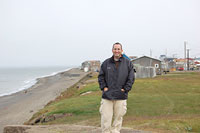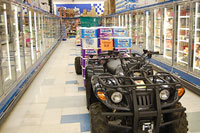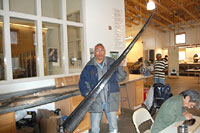

 | |||||||||||||
|
|
Journals 2009/2010Jonathan Pazol
August 5-6, 2009 Leaving Chicago on a bright, sunny, 82° F morning, I said "goodbye" to summer and boarded a plane to Anchorage, Alaska. The flight was uneventful, but I still had about a 3 hour flight to Barrow, including a stop in Fairbanks. In the terminal, I met several other members of the science crew who were going to be working aboard the Coast Guard icebreaker Healy. After a mechanical delay, a plane switch, an unbalanced cargo load, a mistake and rebalancing of the cargo load, and a refueling, we were finally on our way. Once we neared Fairbanks though, we began to circle the area. Forest fires had been raging nearby, and the smoke sitting in the valley reduced visibility to less than 1/4 of a mile. We circled for more than an hour. Then the pilot announced we were returning to Anchorage. Those of us on the plane going to Barrow wanted to continue, but unfortunately, flying is not a democratic process, so despite our call for a vote, we flew back. In Anchorage, we sat on the runway for a while, and then several other people boarded the plane - many of whom had done the same back and forth trip several hours earlier. Finally, the plane departed and we arrived in Barrow around midnight. I have read many descriptions of Barrow, Alaska, but none of them capture the true sense of the place. Barrow is the northernmost permanent settlement in the United States, and at about 72° N latitude is almost 300 miles north of the Arctic Circle. My best description is that the town is a little surreal. In August, the outside looks the same at 1 am as it does at 1 pm - light, dusty, flat, and grey. Fog rolls in and out, but when the sun comes through the clouds, the tundra grasses show a rainbow of colors broken up by small white flowers and other plants nicknamed "arctic cotton" because of the cottony appearance of their seed heads. The Arctic Ocean was slate grey but surprisingly calm. It looked a lot like Lake Michigan in early November.
Many of the buildings throughout the town are trailers or Quonset hut-type buildings. The municipal building and the bank are some of the only buildings taller than two stories. Snow mobiles, seal skins, sleds, whaling boats, BMX bikes, and vehicles with cracked windshields surround many of the houses. Electrical outlets for engine block heaters are a regular feature. The main store in town sells frozen food, All Terrain Vehicles (ATVs), and toilet paper in the same aisle. In a town with no roads linking it to the larger cities in the south and all supplies either coming in by plane or barge, this is not too surprising.
The people I met in Barrow were genuine, open, and proud of their culture and heritage. As we toured around the town or ate in its restaurants, people seemed more than willing to share their stories and interested in what we were doing. We met transplants from Japan, Korea, other parts of Alaska, and people whose families have lived in Barrow or the surrounding communities for generations. We spent some time at the Iñupiat Heritage Center, which contains a variety of exhibits about life in the Arctic and the native Iņupiat culture. The permanent exhibit, People of Whaling, traces the importance, the sense of community, and the respect that the people have for the bowhead whales and their environment. As someone whose gut reaction is to be against whaling, this type of subsistence hunting and the idea that the whale gives freely of itself to the hunters has truly changed my perspective. The Iñupiat display a true sense of ecology and conservation, and in fact their hunts have made some of the most important modern scientific contributions to the survival of this whale population. In the traditional workshop, we met native artists who carved and polished the baleen (long plates from the bowhead whale's mouth, used for filter-feeding) into beautiful art pieces. The unfinished pieces had long, hair-like fibers peeling off the ends. Since baleen is made of keratin, which is one of the same proteins contained in our hair, this made sense.
We had time to tour Barrow because the helicopter that was due to carry us out to the Healy was stuck in Fairbanks. The same fires that prevented planes from landing kept the helicopter from taking off. So, instead of starting to load the ship on Thursday, we waited. Later, the helicopter was clear to leave Fairbanks, but fog in the mountain passes between Fairbanks and Barrow delayed the process again, so we waited some more. At this point, people in charge of logistics were scrambling to find another way to load the ship, but things did not look good. As Larry Mayer, Chief Scientist and leader of this expedition said several times, "Whatever plans you have, be prepared for them to change. It's the Arctic." |
||||||||||||


